Equity & Diversity Annual Report – 2001 Evaluation of the Program
Key Indicators
The data and analysis set out below, together with statistics in Appendix 2, provide a measure of progress of the four designated EEO groups within the Bank, and a benchmark for appropriate future action. In the following analyses, occupational groupings have been determined using the Australian Standard Classification of Occupations (ASCO) codes from the Australian Bureau of Statistics. These are described more fully in Appendix 2. ASCO codes have been utilised by the Bank since 1996.
Overall staff numbers declined this year by 7, which represents quite a static workplace relative to previous years of larger scale restructuring. Recruitment and resignation numbers were very close at 102 and 106 respectively. Resignation figures include redundancies. While there were a number of redundancies these were partially offset by increased staffing associated with the opening of regional offices in Melbourne, Brisbane and Perth. Interestingly, professional staff exited at the same rate in each of the last two years. Reflective of ongoing restructuring, the occupational groups with the greatest number of exits last year were intermediate clerical and elementary clerical. Recruitment statistics also reflected this trend with substantially lower numbers recruited for clerical positions compared to the recruitment of professional staff.
Women
-
As at 30 June 2001 women represented 44% of the Bank's staff, which is consistent with the levels of recent years. When the EEO statistics were first collected in 1987, 48% of staff were women.
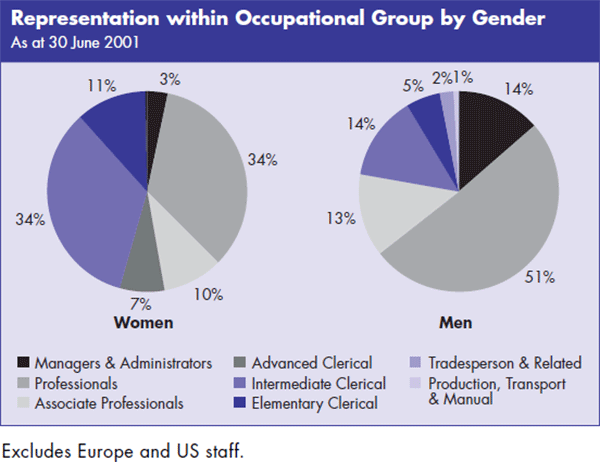
- Women have historically been heavily represented in clerical occupations. During the reporting period a five-year analysis was conducted on the representation of women in clerical positions in the Bank. In 2001 only 34% of total Bank staff were engaged in clerical occupations, compared to nearly 50% of all staff in 1997. In 2001, 52% of all women were in clerical positions, a significant decline from 67% in 1997. The number of women in professional positions has increased from 22% in 1997 to 35% in 2001.
- This year's figures show that women were equally represented in both intermediate clerical and professional positions at 34% and it is expected that this upward trend of women in professional positions will continue.
- 64% of the Bank's staff are in managerial or professional positions. Women held 32% of these positions. The percentage of management positions filled by women at Level 5 and above decreased slightly from 26% last year to 25%. In June 1991, women held only 8% of these management positions.
- Resignations and retirements are shown in separate tables in Appendix 2. Of the 106 staff who resigned from the Bank this year, 49% were women which was similar to last year. Redundancies accounted for only 13% of all resignations this year unlike last year where involuntary redundancies accounted for 43%. Analyses of exit interviews indicated that the main reasons given for resignation remain the same as last year for both men and women. These were concerns about career progression (promotion opportunity, long-term career path) and job-specific issues (recognition given, nature of duties, level of responsibility). A number of staff also indicated they were leaving for personal or family reasons.
-
Age distribution and length of service data provide an interesting profile of the Bank. As a group, female staff are younger than male staff, but the difference continues to narrow. At year-end, 46% of Bank staff were under the age of 35. 50% of women, compared to 43% of men are under the age of 35; the median age overall is 37.
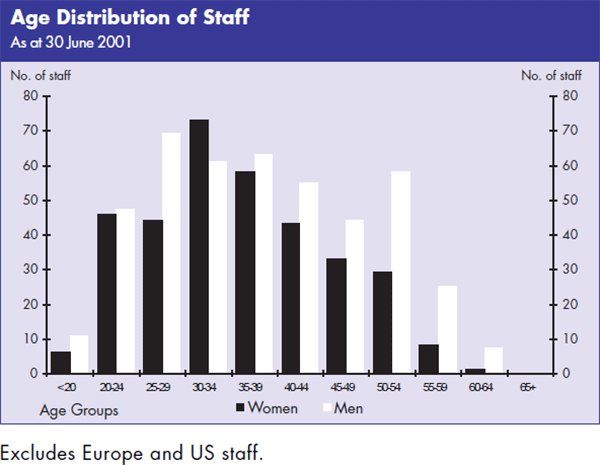
- Length of service statistics provide a snapshot of the Bank's changing workforce. In 1992 14% of staff had been at the Bank for 20 years or more, while 31% had less than 5 years service. Half of all staff had less than 10 years service. Today 21% of all staff have been at the Bank for 20 years or more, while the figures for 10 and 5 year's service have remained about the same.
People from Non-English Speaking Backgrounds
- The representation of people from non-English speaking backgrounds (NESB1 and NESB2) increased to 31% of staff overall. In 1991 it was 19%.
- The proportion of management positions (Level 5 & Above) filled by staff from non-English speaking backgrounds is 16%. For Bank staff as a whole, 21% are in management positions which is the same as last year.
- 54% of the staff from non-English speaking backgrounds are in professional/associate professional occupations. This is comparable to staff as a whole, where 55% are in these occupations.
People with Disabilities and Indigenous Australians
- The representation of Indigenous Australians has remained similar to last year.
- The representation of people with disabilities has remained the same as last year.
- The analysis of the representation of people with disabilities may be conservative since the definition of a disability is subjective, reflecting the opinion of the individual completing the New Appointment Form. Furthermore, fear or embarrassment may reduce the number who are willing to identify their disabilities. A disability acquired after commencing employment is not included in the analysis as the data is only collected at recruitment.
Staff Selection
- 102 staff were recruited this year. Of these, 40% were women, 27% were from non-English speaking backgrounds, and 1% were Indigenous Australians. During the year three people with disabilities were recruited via the Bank's Traineeship program. In the previous year no people with disabilities were recruited, despite the active endeavours of the Bank. Over the ensuing period contacts have been established with employment networks for people with disabilities and this should provide continuing access to a pool of potential applicants.
- 31 graduates were recruited during the year, of which 23% were female graduates. Women represented 34% of the applicants for the Bank's main graduate recruitment drive, which is an increase on the 28% for last year. However, at the end of the selection process women only represented 19% of the final intake. Further investigation has found that the female applicants generally did not perform as well during interview as the males nor were their academic qualifications as strong. A more detailed analysis of graduate recruitment will be conducted during the next reporting period.
- The Bank offered 15 traineeship positions under the New Apprenticeship Scheme during the year. Of these, 8 were women, 3 were people with disabilities and 6 were from non-English speaking backgrounds.
- The number of promotions over the reporting period totalled 119, of which 39% were awarded to women. This is similar to the outcome for last year.
- During the year 148 staff selection panels convened for positions advertised internally and/or externally; a substantial increase on the 111 last year. 93% of panels included a female member and 25% were chaired by a woman, a decrease compared to last year's figure of 33%.
Career Development & Staff Training
-
Last year, information on the highest education level attained by staff was included in the statistics as a way of further enhancing the data on study assistance. From the information available at that time in the Bank's people management system, 39% of Bank staff had a post-secondary or tertiary qualification.
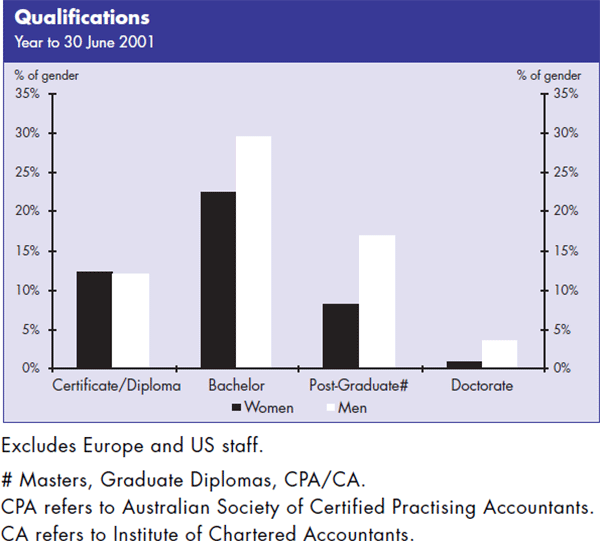
- During the current reporting period staff were asked to update and provide verification of their personal details in the Bank's people management system. The data now shows that 54% of all Bank staff possess a post-secondary or tertiary qualification. Of these, 49% are bachelor degrees and 29% are postgraduate qualifications. There is still a considerable gap between the genders; 44% of all women and 62% of all men in the Bank hold a post-secondary qualification. This partly reflects the Bank's graduate intake, which often mirrors the gender ratio of economics students at university of 30:70 women to men. It may also be a reflection of the Bank's past where women were heavily represented in clerical positions, which required no graduate qualifications. It is proposed to track these statistics over the coming years to better understand the impact of future graduate recruitment.
-
Overall 9% of staff received study assistance, a decline from 11% last year. The decline may be an indication of the increasing number of staff entering the Bank who already have qualifications. Postgraduate studies account for half of the funded study programs currently underway. Interestingly, for the first time in the history of study assistance data, the percentage of both women and men who received study assistance was the same. However, the figures show that women were more highly represented in undergraduate studies (certificates/diplomas and bachelor degrees) compared to men who are still a step ahead at postgraduate and doctorate levels. Study assistance data also include recipients of the Bank's Postgraduate Study Awards (PGSA). During the reporting period there were 9 PGSA recipients of which 3 were women.
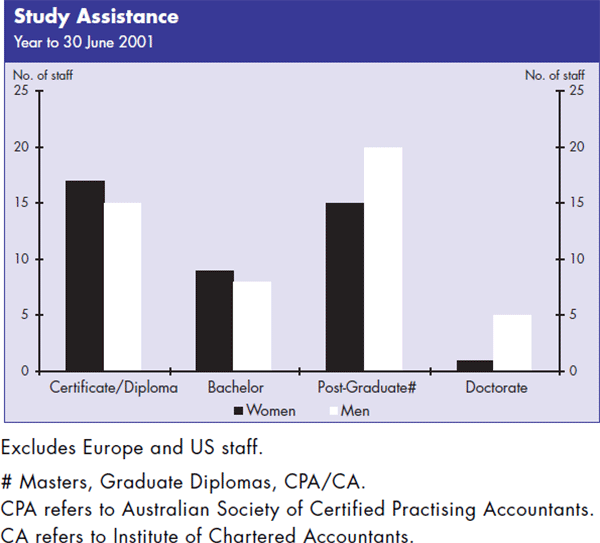
- 62% of staff received formal in-house training, an increase from 57% last year. This year statistics were compiled on the use of Computer Based Training (CBT), which is surpassing the usage rate for the Self-Paced Learning Centre (SPLC). During the reporting period the total number of participant hours for CBT was 292, compared to 252 participant hours in the SPLC. CBT is proving to be a far more convenient training mode for PC skill attainment as it can be done at the employee's own desk.
- 44% of staff attended external training. The gender analysis shows that 41% of women and 47% of men attended external training. 8% of all staff attended overseas courses or conferences. This figure includes those employees who were presenting papers at conferences as well as attending as participants. Overall, 50% of staff attended external courses or conferences during the reporting period.
- This year 16 women attended one or more overseas course(s) or conference(s). Included in this figure are women attending as participants as well as women presenting papers as representatives of the Bank.
- 16 women attended the Springboard Development Program and two female staff members were mentors for the program. Since 1993, 94 women have attended Springboard.
-
There were 76 formal internal staff transfers during the year, a decrease from last year's 99 when the Bank was undergoing intensive restructuring. The overall transfer rate was 8% for women and 13% for men. This was a significant decrease for women compared to last year's figure of 13% and a slight increase for men; up from 11% previously.
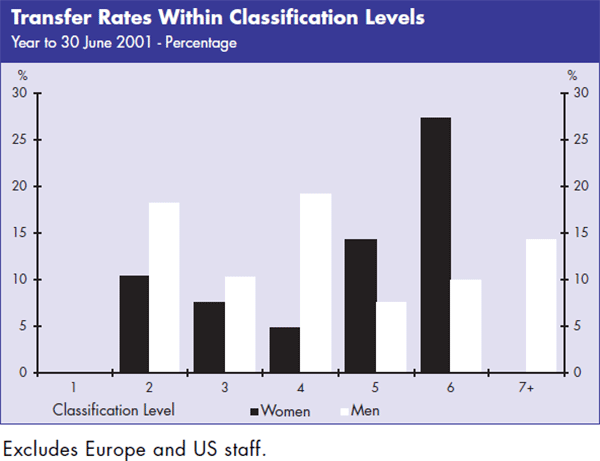
Conditions of Employment
-
4% of women and 3% of men commenced paid parental leave during the year. Men were away for an average of 4.6 days. The available paid paternity entitlement is 5 days.
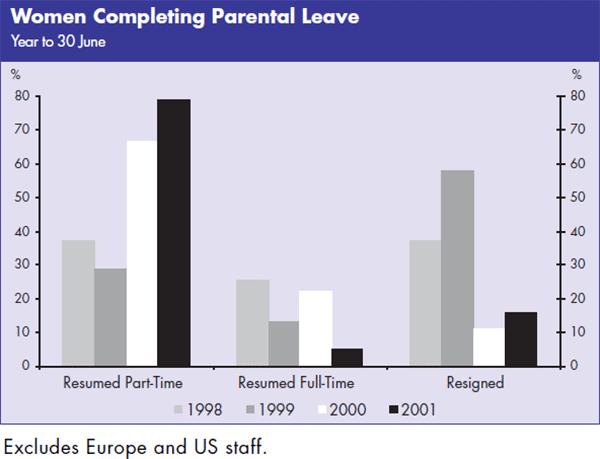
- 84% of women completing parental leave during the year returned to work; this compares to 89% last year and 42% the year before. Statistics will be monitored during the next reporting period to analyse and assess the impact of the amended parental leave arrangements that came into force in January 2000.
- Of the women due to return to work at the end of parental leave, 79% returned part-time and 5% returned full-time. The remainder resigned during parental leave.
- During the year 5% of staff received approval to work part-time. This comprised 37 women and two men from salary Levels 1 through to 7. There were 15 women working part-time contiguous with parental leave. There were 6 employees working in permanent part-time positions and 15 involved in temporary part-time work. Contract staff working on a part-time basis totalled 11. There was one job share arrangement during the year. As at 30 June, 10 staff were on the job share register, indicating their interest to job share.
- 37% of staff took carer's leave during the year, the same figure as last year. This leave was used equally by men and women and the average number of days taken was 2.5.